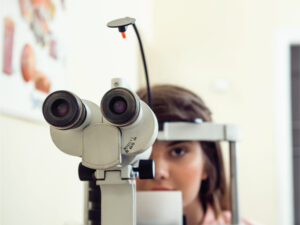
How Diabetes Increases Your Risk Of Fatty Liver Disease
January 19, 2022
How Smoking Affects Both The Risk Of Diabetes & Diabetes Complications
January 19, 2022Diabetic macular edema is a form of eye disease that often develops as a complication of diabetes. It can affect individuals with either type 1 or type 2 diabetes, but is most likely to surface when blood sugar levels are poorly or inappropriately managed. The macula, which is located towards the center of the retina that lines the back of the eye and is filled with blood vessels, is vital for clear vision and focus. High sugar levels cause blood vessel damage, which can also affect blood vessels in the eye, causing fluid to leak. This results in fluid build-up in the macula, causing swelling and thickening that affects vision. In addition to visual impairment, it can also lead to complete vision loss.
Early diagnosis and treatment of the condition can help to stop further loss of vision and may also be able to reverse some of the damage. This is why it’s so important to not only undergo regular eye examinations but to also recognize the warning signs of diabetic macular edema.
Symptoms Of Macular Edema
Diabetic macular edema progresses slowly and in the early stages, you may not even notice any signs of the disease. However, as the condition progresses, you can expect some of the following symptoms:
- Blurring of vision
- Presence of eye floaters
- Double vision
- Washed out or faded appearance of colours
- Loss of vision
Detection & Diagnosis Of Macular Edema

The first step towards diagnosis is a comprehensive dilated eye exam. Eye drops are administered to dilate the pupils, so that the doctor can better observe the retina and detect any signs of damage. Depending on his observation, your doctor may also recommend and perform other tests, which can include:
Visual Acuity Test: This is one of the most commonly used tests to assess visual impairment with the help of a standardized chart that displays rows of letters.
Optical Coherence Tomography (OCT): This test uses a specialized machine to scan the retina, providing detailed information about its thickness; this helps to reveal any swelling in the macula and the extent of swelling if present.
Fluorescein Angiography: This is another test in which the extent of macular damage can be measured. This is done by introducing a dye intravenously so that it travels through the blood vessels. Images of the retina are then recorded using a special camera as the dye travels through the blood vessels.
Amsler Grid: This is a grid of horizontal and vertical lines that have been used since the 1940s to test an individual’s central field of vision. With macular damage, a patient will find some parts of the grid to be missing, blurred, or dark.
What’s Next
Although there is no real cure for diabetic macular edema, the outlook is good when the condition is diagnosed early as treatments can be used to slow disease progression, limiting or preventing further loss of vision. In fact, if the condition is detected in very early stages, diabetic macular edema may even be reversed. Conversely, if left untreated or diagnosed late, it can result in permanent damage to the retina.
References:
- https://www.nei.nih.gov/learn-about-eye-health/eye-conditions-and-diseases/macular-edema
- https://www.diabetes.org/diabetes/complications/eye-complications
- https://www.ajmc.com/view/overview-of-diabetic-macular-edema?p=2
- https://www.aao.org/eye-health/diseases/macular-edema-diagnosis




